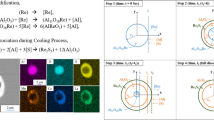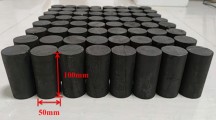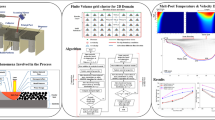Abstract
A computer model has been developed to simulate the distribution behaviors of Ni, Co, Sn, Pb, Zn, As, Sb, Bi, Au and Ag in copper smelting process. The model assumes that the copper smelting furnace is in thermodynamic equilibrium. As many as 21 elements (Cu, S, Fe, Ni, Co, Sn, As, Sb, Bi, Pb, Zn, Au, Ag, O, N, C, H, Ca, Mg, Al, and Si) and 73 compounds are considered. This model accounts for physical entrainment in the melts. The predictions by the present computer model are compared with the known commercial data from Guixi Smelter in China. Horne Smelter in Canada and Naoshima Smelter in Japan. The agreements between the computer predictions and the commercial data are excellent, so that the present computer model can be used to monitor and optimize the actual industrial operations of copper smelting. It is applicable to simulation of almost all copper pyrometallurgical processes.
Similar content being viewed by others
References
Itagaki K. Thermodynamic evaluation of distribution behaviour of VA elements and effect of the use of oxygen in copper smelting. Metallurgical Review of MMIJ, 1986, 3(3): 87
Chaubal P C. Mathematical modeling of minor-element behavior in flash smelting of copper concentrates and flash converting of copper mattes. Metallurgical Transactions, 1989, 20B(12): 39
Shimpo R, Ogawa O, Goto S. An improved computer program for equilibrium calculation. Metallurgical Transactions, 1993, 24A(8): 1882
Shimpo R, Watanabe Y and Goto S. An application of equilibrium calculations to the copper smelting operation. In: Sohn H Y, ed. Advances in Sulfide Smelting. Utah: Americal Institute of Mining, Metallurgical and Petroleum Engineers, 1983. 295
Nagamori N, Mackey P J. Thermodynamics of copper matte converting. Metallurgical Transactions, 1978, 9B: 567
Jalkanen H K, Holppa L E K. Advances in sulfide smelting. In: Sohn H Y, ed. Utah: Americal Institute of Mining, Metallurgical and Petroleum Engineers, 1983. 277
Nagamori M, Mackey P J. Thermodynamics of copper matte converting. Metallurgical Transactions, 1978, 9B(6): 255
Yazawa A, Nakazawa S. Distribution behavior of various elements in copper smelting systems. In: Sohn H Y, ed. Advances in Sulfide Smelting. Utah: Americal Institute of Mining, Metallurgical, Petroleum Engineers, 1983. 90
Sinha S N, Nagamori M. Activities of CoS, FeS in copper mattes and the behavior of cobalt in copper smelting. Metallurgical Transactions. 1982, 13B(9): 461
Sinha S N, Sohn H Y, Nagamori M. Activity of SnS in copper-saturated matte. Metallurgical Transactions. 1984, 15B(9): 595
Sinha S N, Sohn H Y, Nagamori M. Distribution of gold and silver between copper and matte. Metallurgical Transactions. 1985, 16B(3): 53
Takeda Y, Ishinata S, Yazawa A. Distribution equilibria of minor elements between liquid copper and calcium ferrite slag. Transactions of the Japan Institute of Metals, 1983, 24(7): 518
Mackey P J. The physical chemistry of copper smelting slags-A review. Canadian Metallurgical Quarterly, 1982, 21(3): 221
Grimsey E J, Liu X L. The activity coefficient of cobalt oxide in silica-saturated iron silicate slags. Metallurgical Transactions, 1995, 26B(4): 229
Nagamori M, Errington W J, Mackey P J. Thermodynamic simulation model of the Isasmelt process for copper matte. Metallurgical Transactions. 1994, 25B(12): 839
Seo K W, Sohn H Y. Mathematics modeling of sulfide flash smelting process. Metallurgical Transactions, 1991, 22B(12): 791
Nagamori M, Mackey P J, Tarassoff P. Thermodynamics of copper matte converting. Metallurgical Transactions, 1982. 13B(9): 319
Reddy R G, Healy G W. The solubility of cobalt in Cu2O-CoO-SiO2 slags in equilibrium with liquid Cu-Co alloys. Canadian Metallurgical Quarterly, 1981, 20(2): 135
Wan Zhenghua. An outline of operations at the Horne Smelter. Nonferrous Metals Engineering & Research (in Chinese), 1993, 14(4): 18
Goto M. High intensity operation at Naoshima Smelter. Journal of Metals, 1986, 12: 43
Author information
Authors and Affiliations
Additional information
Project supported by the State Economic and Trade Committee
Synopsis of the first author Tan Pengfu, born in 1969, received Ph D degree in 1996, majoring in mathematical modeling of metallurgical process, measuring of transport properties and thermodynamic quantities.
Rights and permissions
About this article
Cite this article
Tan, P., Zhang, C. Computer model of copper smelting process and distribution behaviors of accessory elements. J Cent. South Univ. Technol. 4, 36–41 (1997). https://doi.org/10.1007/s11771-997-0027-y
Received:
Issue Date:
DOI: https://doi.org/10.1007/s11771-997-0027-y




